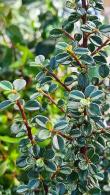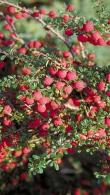Cotoneaster Salicifoli Willeke or Willow-leaved Cotoneaster
Drought-Tolerant Low Growing Cotoneaster with Arching Branches
1. Add items to basket
2. Go to the basket
3. Enter your postcode in Delivery Price Check
Plant shape: Bush
Pot size: 20 Litres
Plant ID: 15289 C 2
View plant size:Cotoneaster Salicifoli Willeke, commonly known as Willow-leaved Cotoneaster, is a versatile low-growing evergreen to semi-evergreen shrub that brings year-round interest to gardens. Known for its graceful, arching branches and fine-textured leaves, this variety is highly valued for its drought tolerance and adaptability. Its spreading habit makes it an excellent choice for ground cover, informal hedging, or adding texture to mixed borders.
This small to medium-sized shrub features elegant, willow-like foliage – narrow, elongated leaves in a deep green shade that turn subtle hues in autumn before falling, depending on the climate. In spring to early summer, clusters of small white to pale pink flowers appear, attracting pollinators and adding a delicate charm. These are followed by vibrant red berries in autumn, which persist well into winter and provide a valuable food source for birds. The arching stems create a soft, natural shape that works beautifully in informal garden designs.
Cotoneaster Salicifoli Willeke is a hybrid, thought to have originated from crosses involving Cotoneaster salicifolius and Cotoneaster watereri. Compared to the low-growing, herringbone-branched Cotoneaster horizontalis, or the larger, denser Cotoneaster lacteus, the Willeke variety offers a more refined, flowing appearance with narrower leaves and a slightly more open structure.
Height and Width of Cotoneaster Salicifoli Willeke
When mature, Cotoneaster Salicifoli Willeke typically reaches 1.5 to 2 metres in height, with a spread of 2 to 3 metres. Its wide-spreading form makes it excellent for covering ground or draping over slopes and walls.
How hardy is Cotoneaster Salicifoli Willeke?
This variety is fully hardy in the UK, tolerating cold winters and thriving in a wide range of soil types. It is also drought tolerant once established, making it a reliable choice for low-maintenance planting schemes.
Uses in Garden and / or Landscape
The Willow-leaved Cotoneaster is highly adaptable. It can be used for erosion control on banks, as a wildlife-friendly hedge, or as part of a mixed shrub border. Its berries attract birds, while its flowers draw bees and other beneficial insects. It also makes an attractive feature when cascading over walls or combined with other shrubs and perennials.
Care Tips
Plant Cotoneaster Willeke in full sun or partial shade, in well-drained soil. Once established, it requires minimal watering and only occasional pruning to maintain shape or control spread. Remove any dead or damaged wood in late winter or early spring. This variety is resistant to most pests and diseases, making it an easy-care choice for both urban and rural gardens.












